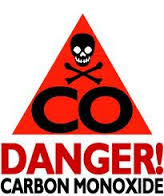The California law regarding carbon monoxide alarms comes from Senate Bill (SB) 183 Carbon Monoxide Poisoning Prevention Act of 2010. It is further explained from the California Residential Code , Title 24, Part 2.5, Chapter 3, Section R315, which explains the proper placement of carbon monoxide (CO) alarms. 
Requirement: CO alarms are required in all dwelling units that have fuel-burning appliances, a fireplace or an attached garage. A fuel burning appliance is generally a water heater, furnace, dryer, stove, oven or generator that uses natural gas, liquid propane or oil (though Californians rarely use oil). But anything that requires fuel to operate is considered a fuel-burning appliance.
Therefore if the home does not have any fuel-burning appliances, a fireplace or an attached garage, a CO alarm is not required. But this is rare, usually in small condos.
Placement: CO alarms are required outside of each separate sleeping area in the immediate vicinity of the bedroom(s). This usually refers to a hall by the bedrooms. But they are also required on every level of the home, whether or not there are bedrooms on that level, including basements.
Please note: Some 1-story homes will require more than 1 CO alarm and some floors of a multi-level home will require more than 1 CO alarm. Here’s why:
Remember it states a CO alarm is required “Outside of each separate sleeping area…” Therefore if there is a master bedroom on one side of the house and the other bedrooms on the other side, 2 CO devices are required.
Finally, the law and Title 24 don’t specify the location on the wall or ceiling, but here are some practical areas to AVOID:
Within 4-inches of the corners of walls and ceilings (dead air space)
Close to air registers or air returns
Close to fuel-burning appliances
Close to garages
Close to main doors
Switched outlet (half hot), where a switch operates the outlet
Behind curtains or furniture



